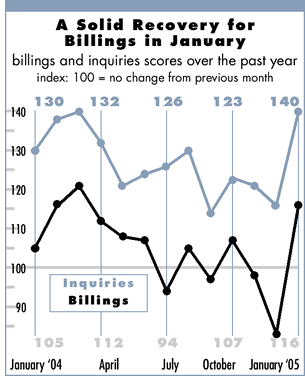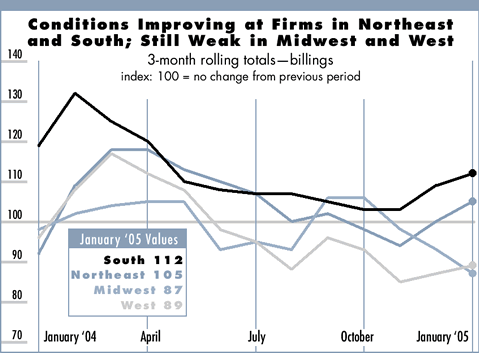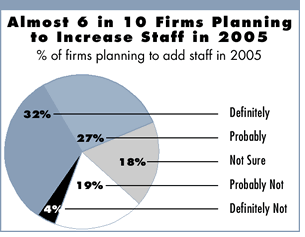

Firms Off to a Strong
Start in January
Most firms planning to add staff this year

by Kermit Baker,
PhD, Hon. AIA
Chief Economist
 Business levels at architecture firms tend to bounce
back in January, but the rebound this time has been unusually sharp.
Almost a third of firms reported an increase in billings in January compared
to December levels, while fewer than 15 percent reported declines. The
improvement was particularly apparent at larger firms. Almost half of
firms with annual billings of $5 million or more recorded an improvement
in January. Some of these gains have to do with weaker than usual billings
during November and December last year.
Business levels at architecture firms tend to bounce
back in January, but the rebound this time has been unusually sharp.
Almost a third of firms reported an increase in billings in January compared
to December levels, while fewer than 15 percent reported declines. The
improvement was particularly apparent at larger firms. Almost half of
firms with annual billings of $5 million or more recorded an improvement
in January. Some of these gains have to do with weaker than usual billings
during November and December last year.
While it is expected that the upturn in design activity eventually will be felt across the board, regional disparities currently exist. Firms in the Midwest reported further erosion in business levels in January, while firms in the West provided some hope that they may be beginning to turn the corner. Business conditions continue to improve for firms in both the Northeast and South.
The strength in design billings was more than matched by a strong upturn in inquiries for new projects. Almost half of firms reported an increase in inquiries in January, while only 9 percent of firms noted a decrease.

Broader economy
slipping
While architecture firms reported stronger conditions in January, the
broader economy didn’t show the same improvement. Business payrolls
increased by only 146,000; the rule-of-thumb is that payrolls need
to grow by at least 150,000 to accommodate new entrants to the labor
force. Construction payrolls declined slightly in January.
Inflation pressures are increasing. Netting out volatile energy and food costs, consumer prices increased 2.7 percent last year, while producer (wholesale) prices increased 1.5 percent. However, both measures were accelerating during the fourth quarter of last year. So even though inflation levels remain in favorable ranges, there is a troubling upward trend. Inflation in construction commodities, which has been a chronic problem for the past 18 months, is likely also to cause problems for the industry in 2005.
The manufacturing sector of the economy slipped a bit in January, according to the Institute for Supply Management’s survey of purchasing managers. So did leading economic indicators, according to the Economic Cycle Research Institute’s leading index. So the economy ended the year a bit softer that it had been earlier in 2004, and seems to be continuing on that trend through January.
 Firms plan to hire
Firms plan to hire
Still, architecture firms are planning to expand. Optimism for a good
year at architecture firms is demonstrated by their hiring plans.
Almost 60 percent of firms are planning on adding staff this year,
and another 18 percent are undecided at this point. Of the firms
expecting to add staff positions this year, over three-quarters (78
percent) plan to add architect positions; 60 percent plan to add
interns or students; 26 percent, other design professionals; 30 percent,
other technical staff; and 30 percent, administrative staff.
A positive note is that firms of all sizes are planning to expand staffing. Almost a quarter of firms with annual billings under $250,000, and more than half of firms with billings between $250,000 and $1 million, plan to expand this year. Not surprisingly, given the construction outlook, 70 percent of commercial/industrial firms plan to increase staff positions. Firms in the Northeast are most optimistic in their hiring plans: more than three-quarters of these firms plan to expand their staffing this year.
Copyright 2005 The American Institute of Architects.
All rights reserved. Home Page ![]()
 |
||
| This month, Work-on-the-Boards survey participants are saying: • Institutional work has been very active and a number
of bond issues are in the planning stage. • January remained even; however, we are beginning to hear
about new projects in the retail and commercial areas. • There seem to be many great opportunities, but competition
is intense. Once selected, the projects start slowly—or not
at all. • Substantial increase in new contacts for work as the East
Coast condominium market continues to rise.
|
||